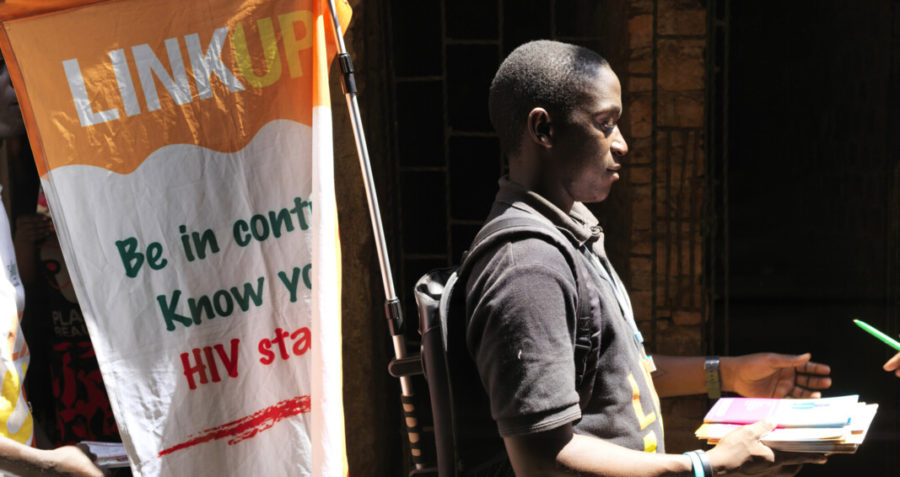Empowering youth in Uganda
 © Frontline AIDS/Peter Caton/2015
© Frontline AIDS/Peter Caton/2015
In Uganda, Link Up has given thousands of young people vital access to HIV and sexual and reproductive health and rights services.
In Uganda – a country where more than two thirds of the population are aged under 24 and almost a quarter of girls become pregnant before the age of 19 – Link Up gave thousands of young people vital access to integrated HIV and sexual and reproductive health and rights (SRHR) services.
Three years after its launch, and over 300,000 young people have received integrated SRHR/HIV services, Link Up in Uganda has come to a close. Community Health Alliance Uganda (CHAU) is now considering the legacy of the programme, its sustainability and the work that remains to be done.
Link Up was launched in 2013 by a consortium of partners led by the International HIV/AIDS Alliance and CHAU was lead partner in Uganda*. The initiative was aimed at strengthening the integration of HIV and SRHR programmes and service delivery, focusing on young people aged 10¬–24. Funded by the Government of the Netherlands, it ran in Bangladesh, Burundi, Ethiopia and Myanmar, as well as Uganda.
In all it reached nearly 940,000 young people.
Empowering youth and giving them the space and resources to demand and take up integrated HIV and SRHR programmes was at its heart.
As Mariam from Kampala says: “I feel inspired that I’m able to reach people… I have the experience and this encourages them to go for services.”
Nicholas from the Uganda Network of Young People Living with HIV (UNYPA), says: “We have these young people with a lot of energy to work with, the innovation and the ideas – we cannot lose this opportunity.”
Access to services
Key legacies of Link Up in Uganda include a cohort of trained peer educatorsand sensitised health workers. One notable success was the establishment in clinics of ‘youth corners’ – areas where young people could meet their peers to ask questions or get support, condoms or information materials.
Rodgers Ampwera, CHAU Director of Programmes, says Link Up’s hallmark was giving young people a voice, “making sure they were engaged, they were involved, and were part and parcel of every step of this project”.
He adds: “It gave young people, young key populations, a platform to express their fears, their views, their aspirations, and how they want the landscape to change in terms of SRHR and HIV… [Youth] are very innovative; they have their own way of doing things.”
Margret Elang, CHAU Programme Manager SRHR/HIV integration, says for her the best part of Link Up was seeing meaningful participation: “Young people were able to talk with vigour. You saw it in their eyes, in their faces… One thing I found fascinating was the friction that came up between health workers and these young men and women demanding services. It showed that young people had grasped the issue of rights.”
Lasting impacts
Although Link Up has ended,CHAU Executive Director Bharam Namanya believes the confidence and voice that Link Up gave young people will continue: “That’s what I would say has been a big impact for Link Up,” he says.
The training provided for health workers, including mentoring in youth-friendly services, will be another lasting impact. “Health workers now see young people as human beings – holistically, and not just as young people, or as sex workers, or as MSM (men who have sex with men). They see them as individuals who need services,” says Gracie Nakazzi, CHAU team lead for communications and community engagements.
Rodgers Ampwera explains that a health worker training curriculum for SRHR and HIV integration for key populations is now being established, and CHAU is working with Uganda’s Ministry of Health to discuss the challenges ahead. “The agenda has been set and I don’t think we can ever go back to three, four years ago,” he says.
In addition, the youth-friendly corners in clinics will remain,and manyof the peer educatorsare being absorbed into other programmes.
Challenges ahead
Despite the successes, much remains to be done. Bharam Namanya says it isstill difficult in Uganda for young people to disclose if they are HIV positive and so discriminationand stigma need addressing.This, he adds, is not helped by the legal framework.
“For example below 18 years no child is supposed to access condoms,” he explains. “The young person, is not supposed to have information, so access to some of the critical services becomes a challenge.”
There is also, says Margret Elang, a need for psychosocial, nutritional and family planning support, placing HIV services alongside strengthening child protection, and continued support for wider empowerment. “The whole person needs to be addressed.”
The long distances young people often have to travel to access services needs tackling too, says Gracie Nakazzi – who also points out that there is much advocacy work ahead, in particular challenging the HIV Bill, whichcriminalises HIV transmission, andthe criminalisation of homosexuality and sex workers.
Broadening the focus
Bharam Namanya says the organisation’s vision and strategic plan will continue to focus on young people. However, there is alsoa need now to look beyond young people and to their families, carers and communities to reduce the stigma of HIV.
But already for many like peer educator Daphine, 19, who is living with HIV and lost her mother to an AIDS related illness, life after Link Up will never be the same again. As she put it: “I thought after my mum’s death I was really going to be nothing. I thought I would die anytime. I just used to sit alone, far from others, and could only talk to the doctor. Because of Link Up I just gained strength of having friends, having fun…
“I really love to live a positive life.”
Find out more about Link Up’s work in Uganda by reading:
_13July2016_RGB_detail.jpg?1471950725)
This article was written as the International HIV/AIDS Alliance, before we changed our name to Frontline AIDS.
Tags
Link UpUgandaYoung people


